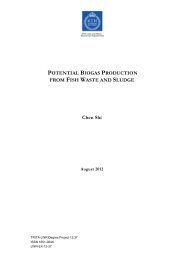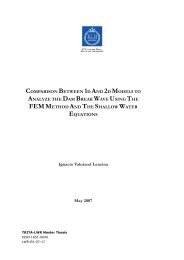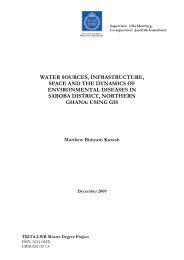radon in groundwater - Mark- och vattenteknik - KTH
radon in groundwater - Mark- och vattenteknik - KTH
radon in groundwater - Mark- och vattenteknik - KTH
- No tags were found...
Create successful ePaper yourself
Turn your PDF publications into a flip-book with our unique Google optimized e-Paper software.
Radon <strong>in</strong> <strong>groundwater</strong> - Influenc<strong>in</strong>g factors and prediction methodology for a Swedish environmentRadon prediction us<strong>in</strong>g Risk VariableModell<strong>in</strong>gThe RV modell<strong>in</strong>g, which was based onl<strong>in</strong>ear regression, generated risk values associatedwith each group of <strong>radon</strong> concentrations.Calibration of the model was based onhalf of the wells compris<strong>in</strong>g the database(2209 wells) and the result is presented <strong>in</strong>the form of a boxplot (Fig. 4).Radon concentrations were classified <strong>in</strong>todifferent concentration ranges based on theregulatory limits applicable <strong>in</strong> Sweden. It wasobserved that risk values became more negativewith <strong>in</strong>creas<strong>in</strong>g <strong>radon</strong> concentrations,although the standard deviations of thegroups were considerable.A test (or validation) of the Risk VariableModel was conducted on the other half ofthe dataset, compris<strong>in</strong>g 2209 wells and distributed<strong>in</strong> 12 subareas. Risk values associatedwith correspond<strong>in</strong>g <strong>radon</strong> concentrationswere computed. The results arepresented <strong>in</strong> the form of a scatterplot(Fig. 5), <strong>in</strong> which the median <strong>radon</strong> concentrationprevail<strong>in</strong>g <strong>in</strong> each area was plottedaga<strong>in</strong>st the correspond<strong>in</strong>g median risk value<strong>in</strong> that area. As can be observed <strong>in</strong> Fig. 5, ahigh negative correlation (-0.87) existedbetween the two plotted quantities, imply<strong>in</strong>gthat the higher the <strong>radon</strong> concentration, themore negative the risk value. A similar trendwas observed <strong>in</strong> the calibration stage.A prediction map <strong>in</strong> GISRaster maps of elevation, bedrock, soil, landuse and uranium concentration <strong>in</strong> bedrockwere reclassified and the different classeswere assigned their correspond<strong>in</strong>g rat<strong>in</strong>gs.An overlay operation was performed to get af<strong>in</strong>al risk map. Each pixel represents a f<strong>in</strong>alrisk value equivalent to the sum of the riskvalues. The factor distance to fracture zonewas not <strong>in</strong>cluded <strong>in</strong> the map productions<strong>in</strong>ce it was not a surface map. Differentwater bodies (e.g. lakes, rivers) were thenadded to the f<strong>in</strong>al map. Three categories ofrisk areas were def<strong>in</strong>ed: Low risk for all f<strong>in</strong>alrisk values, FRV > 0; medium risk for all,–5 < FRV < 0; high risk for all, FRV < -5.The risk map <strong>in</strong> a sample study area isshown <strong>in</strong> Fig. 6.In Paper I, the prediction map based on theRV method was compared to the map of<strong>in</strong>terpolated airborne uranium concentrations<strong>in</strong> the bedrock. It was observed thatsome regions with low to moderate uraniumconcentrations <strong>in</strong> the bedrock were def<strong>in</strong>edas high-risk areas <strong>in</strong> the correspond<strong>in</strong>g RVmap. However, such observations need tobe compared with field measurements <strong>in</strong>future work. It should also be mentionedthat geological materials (bedrock and uraniumdistribution) used <strong>in</strong> the various analysesand available on a scale of 1:50 000 donot always reflect the geological conditionsthat prevail at a specific site.15
















